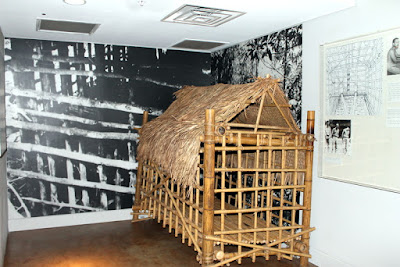While in Americus, in addition to visiting Plains and the President Carter historic site, we also visited the Andersonville National Historic Site. The site includes a museum, a national cemetery and the historic prison camp. At the beginning of the Civil War most prisoners were exchanged so they were not held for long periods. The exchanges stopped when the south refused to exchange Black soldiers who began to serve in the Union Army after the Emancipation Proclamation. Camp Sumter in Andersonville was the site of one of the confederate prisoner of war camps during the last 14 months of the Civil War. Nearly 13,000 soldiers, 29% of those held here, died.
The National Prisoners of War Museum at the site has exhibits on the plight of not only POWs held during the Civil War, but of all American POWs. The building is designed to look like a prison camp with its dark walls and guard towers.
One display deals with the horrible conditions of the Bataan Death March where between 60,000 - 80,000 American and Filipino soldiers were forced to march 60 miles to a prison camp after the fall of the Philippines. Because of the physical abuse during the march it was judged to be a war crime following WWII.
Another exhibit dealt with conditions of American POWs during the Vietnam War where many were kept in solitary confinement. It explains the extent they went to to communicate with various codes to keep their spirits up. Several POWs of that war were held for years including one who was held for nine years.
Being here on a day when it was 95 degrees gave us just a small hint of what it must have been like for the prisoners. They lived in shelters made with whatever they brought with them. The camp was surrounded with a stockade wall with guard towers. Nineteen feet inside the wall was a simple rail fence that marked the dead man zone where they were shot if they crossed it.
The camp covered over 26 acres. The stone pylon marks the corner with the other end near the monuments. On the other corner is the restored wall shown above. The white poles mark the stockade wall and dead man zone fence. The only source of water was a small stream that flowed through the bottom and wells that the prisoners dug themselves.
A drawing of what the camp looked like. It is unimaginable the horror faced by the prisoners. Camp Sumter was just one of several prisons used by both sides during the war and they all had high death rates, but none as bad as here. As a result, the camp commander Swiss-born Henry Wirz was tried, convicted and hung as a war criminal after the war.
Monuments to those who were imprisoned here. Soldiers from eleven northern states died here.
This sculptured wall depicts the struggles of the prisoners. Their only real aid came from their fellow prisoners who all banned together with a common goal of survival. Even the water flowing around the wall is crystal clear at its source then becomes stagnant and scum covered inside the camp.
Andersonville National Cemetery was established in July 1865 as a permanent resting place for deceased veterans. The first to be buried here were the prisoners who died in the prison camp. By 1868 another 800 Union soldiers who either died in the hospital, other prisons, or on the battlefield were interred here bringing the total to over 13,800. While 500 of the graves are marked unknown, most are identified because of Dorence Atwater, a nineteen year old prisoner who worked in the hospital and secretly recorded the names and grave locations of the deceased. After the war he worked with Clara Barton to have the Army publish the register of the dead so families could visit the graves of their loved ones. Because of his work 95% of the graves were identified.
The graves that are close together are those of the solders buried during the Civil War. Those graves are clustered together in three sections of the cemetery.
The cemetery is still an active national cemetery open to all veterans with a total of more than 19,000 interments to date.
Something else we found near Americus is a statue of Charles Lindbergh who bought his first plane and soloed here in 1923. He had been a wing walker and parachutist at aerial circuses but had not piloted a plane. The Army was selling surplus WWI JN-4 Jennys in crates. He bought one and had a few locals put it together for him. He then taught himself to fly, only four years before he became famous as the first person to fly solo and nonstop from New York to Paris.
Americus is a neat old town with many well preserved buildings. The Windsor Hotel that was restored in 2010 is one of the neatest. The city is also the International Headquarters of Habitat for Humanity but we did not have time to visit on this stay.
















3 comments:
Thanks for sharing. We plan on touring that in the fall.
Thank you for this post. Chuck's great, great, great granfather was held as
a prisoner there and died Sept. 4, 1864. He is buried in grave #7820. We
very much want to visit there. C&J
Nice post, I have to admit never really hearing of Civil War POW camps
Post a Comment